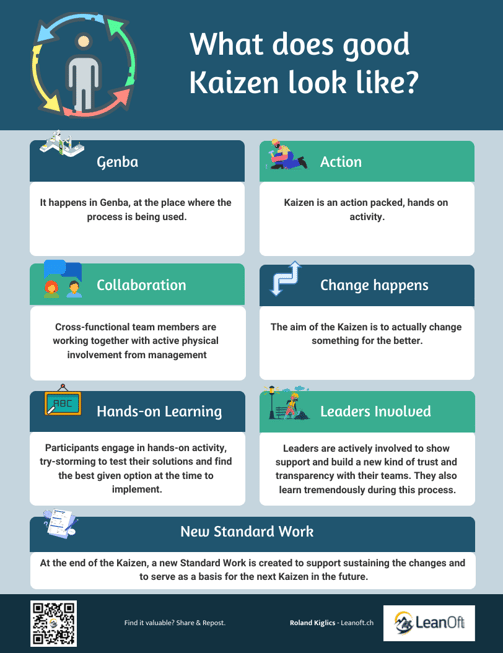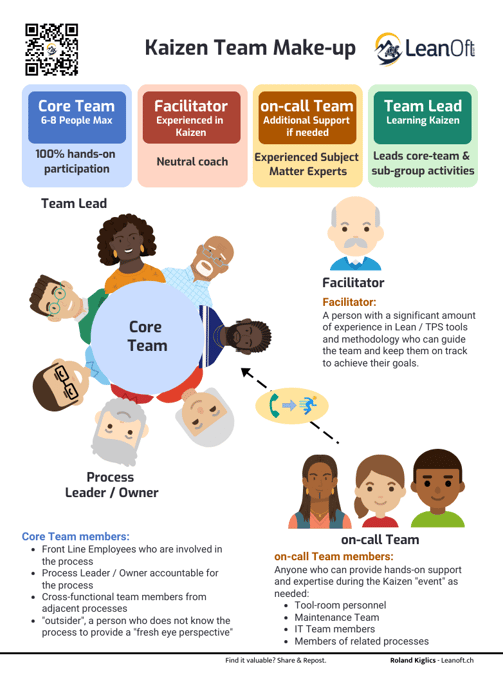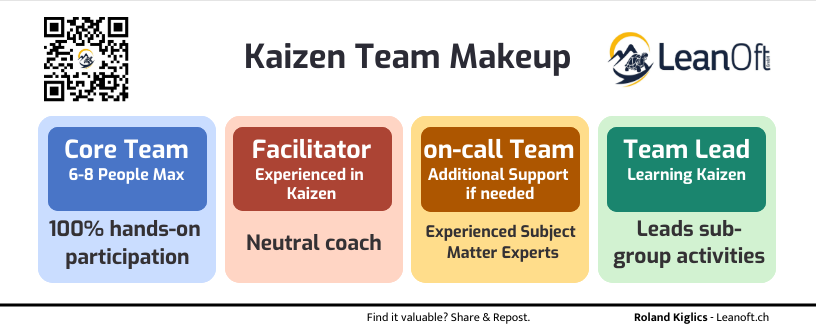Key Elements of a Successful Kaizen "event"
The most important thing is to start somewhere and focus on action. Understand what good looks like.
KAIZENCONTINUOUS IMPROVEMENTLEAN MANAGEMENT CONSULTING
Roland Kiglics
9/23/20248 min read
Introduction
In my previous article "Starting with Kaizen: Kaizen vs. Kaizen “events” vs. Action Workouts", I wrote about what Kaizen and Kaizen “events” are and why they are important for every business in any industry. I described the inherent benefits of conducting a weeklong Kaizen.
We'll focus now on larger, 3-5 days long Kaizen "week" or "event", which is different from smaller so called "point" Kaizen. While “point” Kaizens typically involve 1-3 people, these larger events can involve up to 6 teams each with 6-8 members. Some call these "system" Kaizens.
Let's look at what makes a good Kaizen and how to organise your first multi team, weeklong Kaizen “event”. This overview is for newcomers to Lean/TPS, but it's also a useful refresher for others.
Why choose a week-long Kaizen?
Even mature Lean organisations can use week-long Kaizens to implement strategic improvements linked to Hoshin Kanri and business strategy. They're also ideal for larger improvements that can't be done quickly by just a few people.
Consider your organization's current approach to Kaizen. Are you truly implementing improvements, or are you stuck in Action Workout mode or a Continuous Improvement variant that generates ideas but rarely acts on them? Are you creating extensive action lists that often remain unaddressed?
If this sounds familiar, it's time to shift focus from planning to action. Encourage experimentation, involve your team, and create a blame-free environment for learning. It also includes allowing the Kaizen teams to "fail", it is the best learning. Yes, there might be costs associated with letting your team "fail," therefore, you have to mitigate risks. I'm not saying anything goes, but allowing people to try-storm and make changes will benefit them, the business, and most importantly, your customers.
It provides excellent learning opportunities for all participants, including senior management. After the initial phase, continuing scheduled week-long Kaizens with stretching goals can accelerate business transformation. Even if you're not explicitly transforming, these events are still more effective than traditional project management for implementing strategic improvements.
What do you need to start your first Kaizen “week” or “event”?
You're already on the right track by reading this. Below, you'll find characteristics of a good Kaizen and essential elements for preparing a Kaizen "week" or "event". Of course, you can always contact me for assistance with your first few Kaizens until you get the hang of it. I mention only the first few because the aim is to develop your own skills. There's really no need to keep hiring consultants longterm. Learn, practice, start doing it, and then continue on your own – it's that simple.
Kaizen always takes place in genba—the actual workplace, whether it's a manufacturing floor, laboratory, or office.
It's an ACTION-driven, results-oriented, hands-on activity. Brainstorming and planning occur in the crucial pre-work phase.
Actual changes are made during the Kaizen "week" or "event". Minimal to-do lists remain afterwards. Remember, Kaizen is about DOING, not planning.
Organizational leaders are physically involved, working alongside front-line employees. This involvement is key to transforming company culture and motivating staff.
Those affected by the change must be involved and heard. Operators and front-line workers drive the change, while others enable it through support, decision-making, and resource allocation.
Encourage learning through trial and error or "try-storming" during the event.
Sustainment is critical. Changes should be implemented in a way that prevents reverting to old methods. The new process becomes the new standard, allowing for tracking and fine-tuning, but never returning to previous practices.
0. Start with an understanding of what good Kaizen looks like




1. Ensure you have all you need for a good Kaizen
A problem to solve: Ideally your Kaizen is either linked to your Hoshin-Kanri (business strategy) and / or you are focusing on a problem you have in your current business. If you are just starting out, start with your most important area (value stream). For animal or human hospitals, focusing on early patient discharge or cage/bed turnaround of hospitalized patients could produce the desired impact. If you are a machining company, start by reducing set-up times, creating flow in production and do not forget to focus on office work as well. Kaizen in an office is just as beneficial as anywhere else. For any business in general, focus on the biggest problem that affects many people every day in your biggest value stream.
A team: Composed of 6-8 people with different functions and responsibilities before, during, and after the Kaizen. Limit to 8 for effective collaboration.
Time: Crucial for both preparation and execution. Preparation can take several weeks with active and deliberate effort, involving data collection, analysis, and planning. Allocate 3-5 days for the Kaizen event itself, with 100% active participation (no distractions like meetings, calls, or emails).
A facilitator: Someone experienced in Kaizen to teach, coach, and guide the team. Consider hiring a consultant with relevant experience for your first few Kaizens but only until you develop in-house expertise.
No jumping in and out for meetings
No making phone calls (unless it is in relation to the Kaizen)
No responding to emails (unless it is in relation to the Kaizen)
No finding excuses for why something else is more important than active participation
Important note on time:
100% active participation means full engagement without interruptions. This means during the day on the Kaizen “week”:
These behaviours can break group cohesion, hinder decision-making, and prevent the formation of effective sub-groups. Avoiding these distractions is crucial for maintaining the focus and momentum of the Kaizen process.
Remember, preparation is key and often underestimated. A common insight that often emerges from Kaizen "events" is the desire for more preparation time. Participants often give "More time for preparation next time" as a key takeaway from a Kaizen "event". Ensure enough time and effort is allocated for thorough preparation, as it directly impacts the success of your Kaizen event. This may require team members to step away from their day-to-day activities to focus on gathering data, conducting analyses, and laying the groundwork for an effective Kaizen.
2. Team members’ with clear roles and responsibilities defined:
A. Core participant team: These people are empowered by management to make necessary changes and solve problems. Their role requires 100% participation, as mentioned above, not jumping in and out for meetings, making phone calls or answering emails. Remember, the aim of Kaizen is to improve processes by linking different functions, breaking down silos and creating a flow of information and materials. The members of this team are responsible for implementing the improvements and ensuring that new standardised work is created to sustain the changes and serve as the basis for the next round of improvements.
Cross-functional members who are close to the process.
Salaried and minimum 1 or 2 front-line workers from the affected area, as they have the best insights for improvement.
Upstream and downstream process owners for comprehensive feedback.
Potentially include customers and suppliers to gain a full perspective.
One person as an active member from the middle / senior management team.
B. Support "members" on-call: Since you cannot have everyone on the Kaizen team, identify and inform key people in various supporting adjacent functions including those people who did not fit into the core team but are using the process in focus and could have knowledge supporting the core team. They don't participate full time, but can be brought in briefly during the preparation and the Kaizen activity itself. Their role is to provide specific knowledge, expertise, and implementation support.
Example: IT, maintenance staff, electricians, and tool room personnel.
C. Facilitator: An experienced individual in Kaizen and group facilitation.
Coaching the team on Lean tools and methodologies.
Ensuring focus on targets and preventing scope creep.
Challenging the team to work outside their comfort zone for maximum results.
Maintaining a neutral stance to encourage team-driven solutions.
D. Kaizen Team Lead: Not necessarily a regular team leader, but someone eager to learn about Kaizen through hands-on experience.
Assisting with preparation and leading sub-group activities during the event.
Keeping the team on task and engaged.
Their participation is essential for gaining practical knowledge in conducting Kaizen events, ultimately enabling them to facilitate future events themselves.
E. Process Leader/Owner: Usually a middle or senior manager who is the functional owner and leader of the Kaizen area. In case multiple teams participate in the Kaizen “week”, the process leader / owner is the member of the team responsible for the most challenging improvement.
The process within the scope of the Kaizen.
Responsible for:
Identifying team members and setting the right scope and boundaries.
Ensuring thorough preparation work is carried out.
Supporting the genba team, keeping the sponsor informed, and removing obstacles.
Sending out invitations to demonstrate the event's importance.
Ensuring follow-up and measuring the Kaizen's impact post-event.
Active Participation. As an active member (not as Team Lead nor as co-Team Lead) of the Core participant team, their hands-on involvement demonstrates commitment and accessibility. It also provides immediate decision-making, ensuring alignment with organisational goals and resource allocation if needed.
Post-Kaizen Role: Responsible for monitoring outcome and follow-up to measure the impact of the Kaizen.
F. Sponsor: Typically the top-level organizational leader, though in flatter structures, they may also be the Process Leader.
Removing barriers and enabling the team to act without constraints.
Holding the Process Leader accountable for the Kaizen results and their sustainment.
Acting as a coach alongside the facilitator when needed.
Ensuring resources are available for the team to implement changes effectively.
Impact: Their involvement and active support is crucial in demonstrating commitment to the Kaizen process and reinforcing its importance to the organisation. The active support of the sponsor helps to create an environment that is conducive to successful implementation and long-term improvement.
Role: Crucial for guiding the team effectively throughout the Kaizen process.
Composition of the team:
Impact: Helps spread the Lean mindset and sustains a Kaizen culture across the organisation.
Responsible for:
Accountable for:
Responsible for:
Responsible for:
Their importance: Ensure all necessary resources are available to complete actions during the Kaizen, as there should be no action list at the end; this is about doing, not planning.
In summary, successful Kaizen requires a well-defined structure, clear roles and active participation from everyone. The most important thing is to start somewhere and focus on action. Understand what good looks like by observing your current processes and making adjustments where necessary.
The essence of Kaizen lies not in planning but in doing.
To initiate your first successful Kaizen “event”, consider the following steps:
Conclusion
Empowerment: Ensure that core team members are empowered to make decisions and implement changes.
Preparation: Allocate sufficient time for preparation, involving all necessary stakeholders to gather insights and data.
Active Participation: Encourage 100% participation from the core team throughout the event to maintain focus and momentum.
Support System: Utilize on-call support members to provide expertise and resources as needed, ensuring that the team can act decisively.
Sustainability: Focus on sustaining improvements post-event by measuring outcomes and reinforcing the changes made.
Leadership Involvement: Actively involve process leaders and sponsors to demonstrate commitment and remove barriers. Lead Kaizen events with a future-oriented mindset, not just short-term goals. Consistently lead from the front and be accessible and supportive. Leaders must take a leap of faith to drive Lean/TPS fundamentals to ensure success and achieve desired results.
Embrace the journey of continuous improvement, and watch as your organisation transforms into a more agile and responsive entity, better equipped to meet the evolving needs of customers and the marketplace.
Next Steps
In my next post, I introduce how one can prepare for such a Kaizen. Please click here to read more.
Further reading
Bob Emiliani, Katsusaburo Yoshino, Rudy Go (2015). Kaizen Forever: Teachings of Chihiro Nakao. Wethersfield, Connecticut, USA: CLBM, LLC.
Barney Art (2017). The Lean Turnaround Action Guide: How to Implement Lean, Create Value, and Grow Your People. New York, USA: McGraw-Hill.
“Ask Art: What Was Danaher Like In the Early Days of Lean?” By Barney, Art, 17 September 2020
Video to watch
“Exploring the gaps in people’s understanding of Kaizen” by Emiliani Bob, (2024)
Book Your First Consultation
Get in touch to discuss how LeanOft can help you today.
Get to know us
Do you prefer personal contact over a form? Take the opportunity and write an email to get to know LeanOft and the people behind it.
Quick and Direct Access
Give us a call:
+41779456508
LeanOft GmbH provides hands-on, People-Centered Lean implementation support and problem solving for organizations that want to be better tomorrow than they are today.
LeanOft GmbH is primarily based in Switzerland and is working with companies in Switzerland and in Europe
Follow us
COPYRIGHT © 2025 LeanOft GmbH


+41779456508


